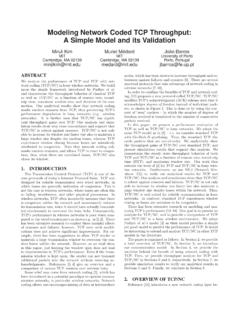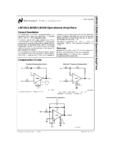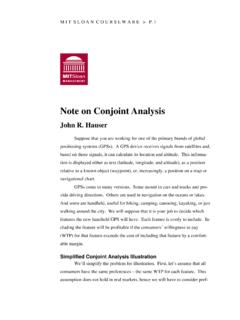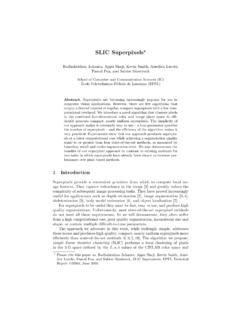Transcription of Conjoint Analysis, Related Modeling, and Applications
1 Conjoint Analysis, Related Modeling, and Applications Chapter prepared for Advances in Marketing Research: Progress and Prospects [A Tribute to Paul Green's Contributions to Marketing Research Methodology]. John R. Hauser Massachusetts Institute of Technology Vithala R. Rao Cornell University September 23, 2002. Conjoint Analysis, Related Modeling, and Applications Origins of Conjoint Analysis Conjoint analysis has as its roots the need to solve important academic and industry problems. Elsewhere in this volume, Carroll, Arabie, and Chaturvedi (2002) detail Paul Green's interest and contributions to the theory and practice of multidimensional scaling (MDS) and clustering to address marketing problems. See also Green and Carmone (1970) and Green and Rao (1972). The strengths of MDS include the ability to represent consumer multidimensional perceptions and consumer preferences relative to an existing set of products.
2 MDS decomposes more holistic judgments to uncover these perceptions and preferences. Paul, with extensive experience in product development from his days at Dupont, sought to augment the power to MDS. He sought a means to decompose consumer preferences into the partial contribution (partworth) of product features. In this manner, researchers could not only explain the preferences of existing products, but could simulate preferences for entirely new products that were defined by feature combinations. Such a method could also be used to decompose perceptions if a perceptual variable, say ease of use was used as the dependent measure rather than preference. This would solve the problem of reverse mapping in MDS . the challenge of translating a point from perceptual space into a corresponding point (or set of points) in product-feature space.
3 This mapping challenge was Related to axiomatic work in psychometrics. Authors such as Luce and Tukey (1964) and Krantz, Luce, Suppes, and Tversky (1971) were exploring the behavioral axioms that would enable a decomposition of an overall judgment. In a seminal paper (Green and Rao 1971), Paul drew upon this Conjoint measurement theory, adapted it to the solution of marketing and product-development problems, considered carefully the practical measurement issues, and opened a flood-gate of research opportunities and Conjoint Measurement or Conjoint Analysis Conjoint measurement has psychometric origins as a theory to decompose an ordinal scale of holistic judgment into interval scales for each component attributes. The theory details how the transformation depends on the satisfaction of various axioms such as additivity and independence.
4 However, in real problems we expect that such axioms are approximate at best. 1. The reviewers of the article were quite apprehensive of the value of this approach. But, the Editor at the time, Professor Ralph Day had the vision to see the enormous potential for this research stream. 1. Conjoint Analysis, Related Modeling, and Applications The real genius is making appropriate tradeoffs so that real consumers in real market research settings are answering questions from which useful information can be inferred. In the thirty years since the original Conjoint analysis article, researchers in marketing and other disciplines, led by the insight and creativity of Paul Green, have explored these tradeoffs. While valid and interesting intellectual debates remain today and while the field continues to advance with new insights, theory, and methodology, we are left with the legacy of an elegant theory being transformed into an evolving research stream of great practical import.
5 While the earlier, axiomatic work is often called Conjoint measurement, we choose to call the expanded focus Conjoint analysis. Paul Green's Contributions Paul Green himself has contributed almost 100 articles and books on Conjoint analysis. He was there in the beginning and he is there now. He has embraced (or led) new developments including the move to metric measures (Carmone, Green, and Jain 1978), evaluations of non- additivity (Green and Devita 1975), hybrid methods to combine data sources and reduce respondent burden (Green 1984), and new estimation methods such as hierarchical Bayes methods (Lenk, et. al. 1996). He has further led the way with seminal Applications such as the application of Conjoint analysis to really new products such as Marriott's Courtyard (Wind, et al. 1989) and the EZPass system (Green, Krieger, and Vavra 1999).
6 It is safe to say that Conjoint analysis would not be where it is today without Paul's leadership. In this paper we pay homage to Paul by reviewing some of the enormous breadth of research in Conjoint analysis. We try to highlight many of the theoretical and practical issues and we try to illustrate many of the contributions of the past thirty years. In a field so vast, we can provide but an overview. We encourage our readers to explore this field further. Our focus is on the measurement and representation of consumer preferences. A companion paper in this volume reviews buyer choice simulators, optimizers, and the dynamic models that use Conjoint - analysis data (Green, Krieger, and Wind 2002). Conjoint Analysis is a Journey not a Destination The essence of Conjoint analysis is to identify and measure a mapping from more detailed descriptors of a product or service onto a overall measure of the customer's evaluation of that 2.
7 Conjoint Analysis, Related Modeling, and Applications product. We begin with an example from Paul's classic paper (with Jerry Wind) that was published in the Harvard Business Review (1975). Paul and Jerry were designing a carpet cleaner and chose to describe the carpet cleaners by five features: package design one of three levels illustrated in Figure 1. brand name one of three brand names K2R, Glory, and Bissell seal either the carpet cleaner had a Good Housekeeping seal of approval or it did not guarantee either the carpet cleaner had a money-back guarantee or it did not price specified at the three discrete levels of $ , $ , and $$ Respondents were given a fractional factorial design of profiles, each of which was described by the levels of the features it contained, and were asked to rank order cards representing the profiles in order to indicate their preferences for the profiles.
8 Because a full 3x3x2x2x3 design would have yielded 108 profiles, they chose a balanced orthogonal design kept the respondent's task within reason each respondent had to rank but 18 profiles. When the data collection was complete, Paul and Jerry assumed that the overall preference was an additive sum of the partworths of the features, represented each feature by a series of dummy variables, and used monotonic regression to estimate the contribution of each feature to overall preference. In this manner partworths were obtained for each respondent enabling the researchers flexibility to (1) cluster the partworths to identify segments and (2). simulate preferences for new products by adding those products to the respondents' choice sets and re-computing the implied preferences. (Here they assumed that each respondent would purchase their most preferred product.)
9 In the twenty-seven years since this article was published (thirty-one years since the pioneering Green and Rao 1971 article), much has changed, but the basic structure of the Conjoint challenge remains. We organize this short review around the elements pioneered by Paul and provide examples of how each element has evolved. Because of the sheer breadth of today's Applications , we have space but to highlight the most common examples. The basic elements of our review are: how a product or service is decomposed (additive function of five features in 1975). stimuli representation (cards in 1975). methods to reduce respondent burden (orthogonal factorial design in 1975). data collection format (rank order of cards in 1975). 3. Conjoint Analysis, Related Modeling, and Applications estimation (monotonic regression in 1975). In another paper in this volume, Green, Krieger, and Wind (2002) address how Conjoint estimates are used to segment the market, identify high-potential product designs, plan product lines, and forecast purchase potential.
10 Decomposing the Product or Service There are at least two considerations in decomposing the product or the service: (1) the elements into which the product is decomposed and (2) the function by which the elemental decomposition is mapped onto overall preference. In the carpet-cleaner example, the elemental decomposition was into physical features. This has been the most common application of Conjoint analysis in the last thirty years and is the most relevant if the product-development team is facing the decision about which features to include in a product design. However, Conjoint analysis has also been used with more qualitative features such as personalness, convenience, and quality of health care, ( , Hauser and Urban 1977). Such Applications occur early in the product-development process when the team is trying to understand the basic perceptual positioning of the product or service.
















